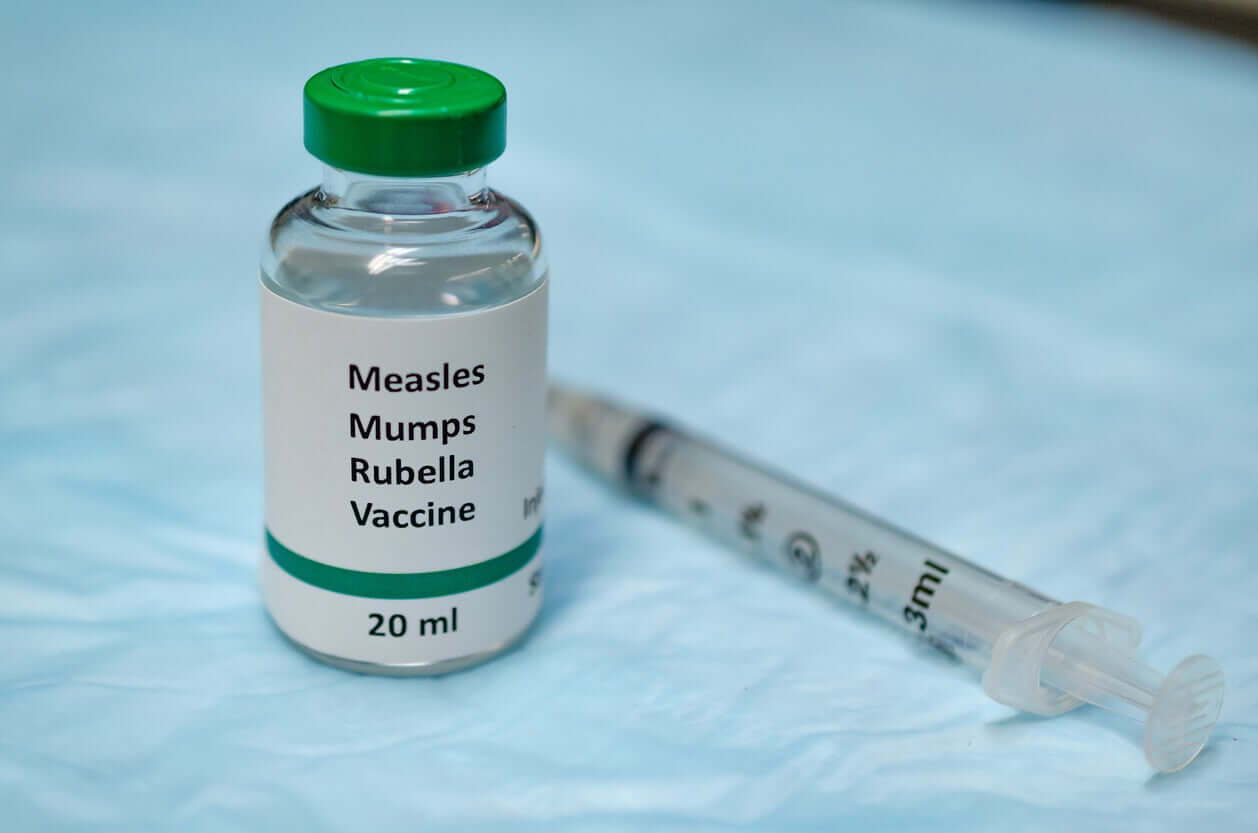Koplik's Spots: What You Need to Know


Written and verified by the dermatologist Maria del Carmen Hernandez
Koplik’s spots are spots on the oral mucosa, which are very characteristic of the primary stage of measles. In general, they’re part of the prodrome of the disease, they’re not contagious, and they resolve on their own after a few days. Do you want to know more about them? We’ll tell you everything you need to know in the following article.
Why do Koplik’s spots appear?
Koplik spots inside the mouth usually appear the day before the typical measles skin rash. They take their name from the person who first described them in 1896, the American pediatrician Henry Koplik.
These lesions are whitish in color, are slightly raised, and have a diameter of 2 to 3 millimeters. They settle on a base of reddened mucosa, which is why this sign is described as “grains of salt on a red background”.
In addition to the oral mucosa, Koplik’s spots can appear on the soft palate, the conjunctival crease (eyes), and on the mucosa of the vagina or intestine.
Also read: Café-au-Lait Spots in Children
What is measles?

Measles is a very frequent exanthematic or eruptive disease of childhood, especially before the incorporation of its vaccine into the mandatory schedule.
In the pre-vaccine era, it was one of the main causes of infant mortality and morbidity, due to its high contagion with direct exposure.
To avoid the spread of the virus, it’s very important to make an early diagnosis and, therefore, Koplik’s spots are a key element.
The relationship of Koplik’s spots to measles
In 60% of measles cases, these spots are present before any other symptoms of the disease.
As the skin lesions expand, these mucosal spots begin to fade. After a few days, the mucosa returns to its normal state and the rash takes center stage.
Measles phases
According to the evolution of the disease and the symptoms that appear at each moment, four phases of measles have been defined:
- Incubation phase: Includes the first 7 days after contact with the virus, during which the child has no symptoms.
- Prodromal phase (catarrhal): This phase begins with fever, after which come cough, catarrh, conjunctivitis, and enanthema (Koplik’s spots). This combination of symptoms is known as a triple cold.
- Skin rash phase: This phase is characterized by the typical skin rash or breakout of the disease.
- Recovery phase.
In addition to these symptoms, measles can lead to ear infections, pneumonia, or brain damage.
You may be interested: 10 types of dermatitis in children
What does the treatment of measles involve?
Measles is an acute viral disease that’s highly contagious and, fortunately, preventable.
Currently, there’s no specific therapeutic option. Rather, only symptomatic treatment is available to accompany the natural process until resolution.
The management of fever, the prevention of dehydration, and the correct isolation measures, are matters of utmost importance for the health of the child and those around them.
However, the World Health Organization (WHO) also recommends giving a daily dose of vitamin A to children with measles. This supplement helps to maintain the blood levels of this vitamin within normal ranges and this strategy appears to be effective in preventing blindness or eye damage.
The prevention of measles

The mainstay for controlling this disease and its complications is universal vaccination. This not only prevents infection but also limits the spread of the virus within the community.
In developed countries, children receive a composite live virus vaccine, which includes protection against mumps, measles, and rubella. The name of this medicine is viral vaccine MMR (measles, mumps, rubella).
The Centers for Disease Control and Prevention (CDC) recommends the following immunization schedule with the MMR vaccine:
- First dose: Between 12 and 15 months of age
- Second dose: Between 4 and 6 years old, prior to entering school
In addition, it’s important to administer an extra dose in babies from 6 to 11 months who travel to an area with a high circulation of these viruses or in the event of outbreaks in their community.
Final thoughts on Koplik’s spots
Koplik’s spots precede the rest of the clinical manifestations of measles and are very characteristic of this disease. In fact, verifying is enough to suspect the diagnosis.
For this reason, identifying them early is essential in order to indicate the child’s isolation and to provide the necessary relief measures.
Koplik’s spots are spots on the oral mucosa, which are very characteristic of the primary stage of measles. In general, they’re part of the prodrome of the disease, they’re not contagious, and they resolve on their own after a few days. Do you want to know more about them? We’ll tell you everything you need to know in the following article.
Why do Koplik’s spots appear?
Koplik spots inside the mouth usually appear the day before the typical measles skin rash. They take their name from the person who first described them in 1896, the American pediatrician Henry Koplik.
These lesions are whitish in color, are slightly raised, and have a diameter of 2 to 3 millimeters. They settle on a base of reddened mucosa, which is why this sign is described as “grains of salt on a red background”.
In addition to the oral mucosa, Koplik’s spots can appear on the soft palate, the conjunctival crease (eyes), and on the mucosa of the vagina or intestine.
Also read: Café-au-Lait Spots in Children
What is measles?

Measles is a very frequent exanthematic or eruptive disease of childhood, especially before the incorporation of its vaccine into the mandatory schedule.
In the pre-vaccine era, it was one of the main causes of infant mortality and morbidity, due to its high contagion with direct exposure.
To avoid the spread of the virus, it’s very important to make an early diagnosis and, therefore, Koplik’s spots are a key element.
The relationship of Koplik’s spots to measles
In 60% of measles cases, these spots are present before any other symptoms of the disease.
As the skin lesions expand, these mucosal spots begin to fade. After a few days, the mucosa returns to its normal state and the rash takes center stage.
Measles phases
According to the evolution of the disease and the symptoms that appear at each moment, four phases of measles have been defined:
- Incubation phase: Includes the first 7 days after contact with the virus, during which the child has no symptoms.
- Prodromal phase (catarrhal): This phase begins with fever, after which come cough, catarrh, conjunctivitis, and enanthema (Koplik’s spots). This combination of symptoms is known as a triple cold.
- Skin rash phase: This phase is characterized by the typical skin rash or breakout of the disease.
- Recovery phase.
In addition to these symptoms, measles can lead to ear infections, pneumonia, or brain damage.
You may be interested: 10 types of dermatitis in children
What does the treatment of measles involve?
Measles is an acute viral disease that’s highly contagious and, fortunately, preventable.
Currently, there’s no specific therapeutic option. Rather, only symptomatic treatment is available to accompany the natural process until resolution.
The management of fever, the prevention of dehydration, and the correct isolation measures, are matters of utmost importance for the health of the child and those around them.
However, the World Health Organization (WHO) also recommends giving a daily dose of vitamin A to children with measles. This supplement helps to maintain the blood levels of this vitamin within normal ranges and this strategy appears to be effective in preventing blindness or eye damage.
The prevention of measles

The mainstay for controlling this disease and its complications is universal vaccination. This not only prevents infection but also limits the spread of the virus within the community.
In developed countries, children receive a composite live virus vaccine, which includes protection against mumps, measles, and rubella. The name of this medicine is viral vaccine MMR (measles, mumps, rubella).
The Centers for Disease Control and Prevention (CDC) recommends the following immunization schedule with the MMR vaccine:
- First dose: Between 12 and 15 months of age
- Second dose: Between 4 and 6 years old, prior to entering school
In addition, it’s important to administer an extra dose in babies from 6 to 11 months who travel to an area with a high circulation of these viruses or in the event of outbreaks in their community.
Final thoughts on Koplik’s spots
Koplik’s spots precede the rest of the clinical manifestations of measles and are very characteristic of this disease. In fact, verifying is enough to suspect the diagnosis.
For this reason, identifying them early is essential in order to indicate the child’s isolation and to provide the necessary relief measures.
All cited sources were thoroughly reviewed by our team to ensure their quality, reliability, currency, and validity. The bibliography of this article was considered reliable and of academic or scientific accuracy.
- Lefebvre N, Camuset G, Bui E, Christmann D, Hansmann Y. Koplik spots: a clinical sign with epidemiological implications for measles control. Dermatology. 2010;220(3):280-1. doi: 10.1159/000277122. Epub 2010 Jan 26. PMID: 20110626.
- Tanaka M, Harada T. Koplik spots in measles. Postgrad Med J. 2019 Aug;95(1126):454. doi: 10.1136/postgradmedj-2019-136739. Epub 2019 May 30. PMID: 31147397.
- Bello S, Meremikwu MM, Ejemot-Nwadiaro RI, Oduwole O. Routine vitamin A supplementation for the prevention of blindness due to measles infection in children. Cochrane Database Syst Rev. 2016 Aug 31;(8):CD007719. doi: 10.1002/14651858.CD007719.pub4. PMID: 27580345.
- CALENDARIO DE VACUNACIONES AEP 2021. Disponible en: https://vacunasaep.org/profesionales/calendario-de-vacunaciones-de-la-aep-2021
This text is provided for informational purposes only and does not replace consultation with a professional. If in doubt, consult your specialist.








